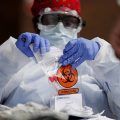
ABOVE PHOTO: Healthcare worker Rahaana Smith instructs passengers how to use a nasal swab, Friday, July 24, 2020, at a drive-thru COVID-19 testing site at the Miami-Dade County Auditorium in Miami, Florida. (AP Photo/Wilfredo Lee)
By Mike Stobbe
ASSOCIATED PRESS
NEW YORK — If Black, Hispanic and Native Americans are hospitalized and killed by the coronavirus at far higher rates than others, shouldn’t the government count them as high risk for serious illness?
That seemingly simple question has been mulled over by federal health officials for months. And so far the answer is no.
But federal public health officials have released a new strategy that vows to improve data collection and take steps to address stark inequalities in how the disease is affecting Americans.
Officials at the Centers for Disease Control and Prevention stress that the disproportionately high impact on certain minority groups is not driven by genetics. Rather, it’s social conditions that make people of color more likely to be exposed to the virus and — if they catch it — more likely to get seriously ill.
“To just name racial and ethnic groups without contextualizing what contributes to the risk has the potential to be stigmatizing and victimizing,” said the CDC’s Leandris Liburd, who two months ago was named chief health equity officer in the agency’s coronavirus response.
Outside experts agreed that there’s a lot of potential downside to labeling certain racial and ethnic groups as high risk.
“You have to be very careful that you don’t do it in such a way that you’re defining a whole class of people as ‘COVID carriers.’” said Dr. Georges Benjamin, executive director of the American Public Health Association.
COVID-19’s unequal impact has been striking:
— American Indians and Native Alaskans are hospitalized at rates more than five times that of white people. The hospitalization rate for Black and Hispanic Americans is more than four times higher than for whites, according to CDC data through mid-July.
— Detailed tracking through mid-May suggested Black people accounted for 25% of U.S. deaths as of that time, even though they are about 13% of the U.S. population. About 24% of deaths were Hispanics, who account for about 18.5% of the population. And 35% were white people, who are 60% of the population.
Other researchers have pointed out problems for minorities as they try to access coronavirus tests or health care.
But while sometimes highlighting the disproportionate toll the virus has had on certain racial and ethnic groups, the CDC is being careful not to categorize them as high risk or meriting higher priority for certain health services.
Indeed, in May, the CDC took down guidelines it had posted that said minorities without symptoms should be among those prioritized for coronavirus testing. Government officials later said the posting had been a mistake.
Last month, the CDC revised its list of which Americans are at higher risk for severe COVID-19 illness, adding pregnant women and people with certain underlying conditions. Race and ethnicity were left out.
On Friday, the CDC issued a racial equity strategy document vowing better data collection on how the virus is impacting minorities. It also calls for improvements in testing, contact tracing, and safely quarantining, isolating and treating minorities at risk. The agency also said it will take steps to diversify the public health workforce responding to the epidemic.
The agency did not immediately provide details about any added funding for this work. But it’s more than has been done by the agency in the past, some health experts said.
Dr. Richard Besser, chief executive of the Robert Wood Johnson Foundation, previously spent 13 years at CDC. He ran the agency’s emergency preparedness response for four years and was acting director when a pandemic flu hit the U.S. in 2009.
“I can tell you that we spent very little time on talking about who was able to follow our recommendations and who was not,” he said.
He sees many public health recommendations that “seem to have been created without any recognition of the conditions in which millions and millions of Americans live.”
People who are required to go to work to stock grocery store shelves or drive buses don’t have the luxury of working at home. They also may not have a place to stay, away from others, if directed to go into quarantine or isolation. And many are minorities, experts said.
Dr. Michelle LaRue sees that. A senior manager at an organization called CASA that helps Latinos and immigrants in Maryland, Virginia and Pennsylvania, she said lack of paid sick leave in industries in which many Latinos work, such as construction, forces people to pick between “feeding their families or staying home to self-isolate.” And multi-generational and multi-family housing settings are often people’s only choice.
The CDC appointed Liburd, an agency veteran, in May to better address such issues — the first time the agency had created that kind of leadership role for an epidemic. The goal was to make her a central figure in the agency’s coronavirus work, with input on research and other tasks.
Data collection will be key.
When doctors order coronavirus tests for patients, standard forms ask for important patient information, said Janet Hamilton, executive director of the Atlanta-based Council of State and Territorial Epidemiologists.
But physicians often don’t ask. Race and ethnicity data is missing 80% to 85% of the time, and patient address and phone number is missing as much as 50% of the time, Hamilton said.
Advocates have pushed for improvements for years, she said, “but it’s never been prioritized or incentivized.” Public health officials “find it painful — quite honestly — at how incomplete the data is,” she said.
David Holtgrave, dean of the School of Public Health at University at Albany, said he hoped CDC can help push progress in race and ethnicity data for testing, hospitalizations and deaths.
“Completeness of that data should be our goal,” Holtgrave said in an email.

















Leave a Comment